"The time which I have been thrown into does not interest me."
- Odd Nerdrum
Pupils of Apelles, a four person exhibition now on view at Copro Gallery, is about reaching far back in time for inspiration and connection. Although the Norwegian artist and mentor Odd Nerdum appears in the largest font on the show's roster, it is the 4th century Greek artist Apelles of Kos who is presented as the presiding master of its cult.
The invoking of Apelles may strike some as a kind of smokescreen, as show's star attraction is Nerdrum, an aesthetic refusenik who once painted himself in a custom-sewn golden robe as The Savior of Painting. Whatever you may think of Nerdrum's art -- and his ego -- you have to grant him this: no living "master" has magnetized more ambitious and talented young representational painters than he has. Yes, offering up his own art as a model is part of what Nerdrum does, but to be fair, Nerdrum's approach has also involved asking his students to look far outside the perimeters of current tastes in art: that is where Apelles enters into things.
![2014-12-03-nerdrum_trac.jpg]()
Odd Nerdrum: Photo by John Seed
"Rather than dialogue and cooperatively compete with contemporaries," explains painter David Molesky, "Nerdrum has taught us the benefit of ignoring the packaging of time and to strive with masters of the past as if they were our peers." Striving to create an artistic dialogue with Apelles involves both research and considerable imagination since none of his works have survived, except in copies and descriptions.
History has noted Apelles as being an early advocate of a tetrachrome (four color) palette consisting of white, yellow ochre, red ochre and black: from this basic set of pigments a wide range of tints including flesh tones could be mixed. Apelles' technique also presages European oil painting methods: in his Natural History Pliny the Elder says that Apelles used a varnish on his paintings that 'caused a radiance in the brightness of all the colours and protected the painting from dust and dirt.' A lyrical painter whose works are recorded as having employed elaborate allegories and personifications, Apelles made a number of portraits of Alexander the Great including one of the young ruler wielding a thunderbolt.
Molesky, who studied with Odd Nerdrum between 2006 and 2008 says that the legend of Apelles came up as they looked over a book of Pompeian frescoes: Nerdrum told him that the paintings preserved by the ashes of Vesuvius were "copies upon copies" that echoed the original great works of Apelles.
"It really triggered my imagination," Molesky recounts, "to think about what these paintings must have looked like, these invisible paintings -- all destroyed 1200 years ago -- that were esteemed by Rembrandt, Titian, Botticelli and others as the greatest works ever, even though they had never seen them." Raphael, another admirer, portrayed himself as Apelles in his fresco The School of Athens which graces the Vatican's Apostolic Palace. In a sense, striving to emulate Apelles offers up the fantasy of joining what Molesky describes as "a secret bloodline of painters whose imaginations were ignited into fierce striving when the imagination was set to try and create something worthy of the Greek master."
![2014-12-03-BMaenads.jpg]()
Odd Nerdrum, Maenads, 2014, oil on canvas, 75 x 106 inches
What would Apelles have thought of the rivetingly strange Maenads, the largest of six Nerdrum canvases on view at Copro? The subject is classical: maenads were women who resisted the worship of Dionysius and were driven mad by being forced to participate in rituals against their wills. Its seven nude figures, who rise from an ashen scrim of water, glower accusingly toward the viewer offering variations on the theme of refusal. One of them, second from the right, is androgynous or even masculine: in fact she/he resembles Nerdrum. Just what are these unwilling Northern bacchants accusing us of? I'm guessing fatuousness and inanity: their resistance and suffering are the emblems of their character. Like the asylum inmates that Gericault painted, Nerdrum's Maenads are to be both pitied and admired.
![2014-12-03-IMG_5234.JPG]()
Maenads, (Detail)
The characters in Nerdrum's paintings have some pretty weird circuses going on in their heads, and to like his paintings you have to buy into the lugubrious strangeness, which not everyone does. Jenny Dubnau, a realist painter who earned her MFA at Yale, argues that Nerdrum's imagery is "...like a parody of a Wagner opera or something: it feels like a very false, silly mythology that has no relevance to anything real in our culture. He himself describes his work as kitsch, but there's zero humor to it, so it's intensely unlikable." In contrast, the late critic Hilton Kramer (1928-2012) found Nerdrum's works valuable as cautionary tales: "They reject the present and exploit the past in favor of pictorial fable, allegory and myth that offers the viewer a grim symbolic account of the human condition in extremes."
For the past few decades, young artists interested in classical training -- exactly the "wrong" approach in an era dominated by postmodern theory -- have looked to Nerdrum as a beacon. His Road Warrior meets Rembrandt imagery and his considerable facility have made him a figure of considerable adulation. Luke Hillestad came to study at Nerdrum's farm after an art school put-down helped him clarify his sense of difference:
![2014-12-04-IMG_5228.JPG]()
A detail of Luke Hillestad's Abyss
Hillestad's melodramatic painting Abyss which depicts couple kissing in a water-filled cavern shows the tenderness and luminosity that was encouraged under Nerdrum's tutelage. Migration, Hillestad's image of a nomadic clan seems to be located in the precise mythological zone that Nerdum has invented, but its figures and surface are more carefully burnished. There is a hint of Pre-Raphaelite grace in Hillestad's female figures that gives his work its distinctive mood.
![2014-12-04-Luke_Norway_2013.jpg]()
Luke Hillestad at work on his painting Migration in Norway, 2013
Caleb Knodell, who is represented by three oils including his glowering Self-Portrait as Possessed, found that his studies with Nerdrum offered both a sense of belonging and the support he needed to attempt challenging subject matter:
![2014-12-04-ZCalebKnodellmalm3.jpg]()
Caleb Knodell, Self-Portrait as Possessed, oil on linen, 49 x 50 inches
David Molesky, who first worked as an apprentice and model for Nerdrum at his studio in Iceland, found that his best moments with Nerdrum mainly consisted of watching Nerdrum paint and listening to his cultural anecdotes. Studying painting with Nerdrum -- in Paris, Reykjavik or Memorosa -- is rather like studying architecture with Frank Lloyd Wright at Talesin: just being in the presence of the master can be the most important aspect. Rose Freymuth-Frazier, who studied with Nerdrum in 2005 says: "Odd's very compelling, generous etc. A lot of people looking for that influence in their lives find that, even temporarily in him. He's bigger than life and he has the artistic mastery to back it up."
![2014-12-04-atNerdrums.jpg]()
David Molesky painting at Odd Nerdrum's farm in Norway.
Of course, the adulation of masters is something that has to come to an end at a certain point. When asked why had had left the studio of the sculptor Rodin, Constantin Brancusi famously replied: "No other tree can grow in the shadow of a great oak." For that reason, David Molesky's paintings, which have moved from Nerdrum's Nordic mythological zone into a contemporary world filled with depictions of fiery confrontations and conflagrations, offer a welcome indication of artistic separation and maturation.
![2014-12-04-KfrfaceToAir18x20sm.jpg]()
David Molesky, Surface to Air, oil on canvas, 18 x 20 inches
From Odd Nerdrum, his first master, Molesky learned the importance of drama and atmosphere. Apelles, his second master, helped him realize that the imagination is a much broader field than any one person could ever show you. Artists who never walk away from the shadows of their masters risk being what the Greeks called epigones: less distinguished followers or imitators.
Pupils of Apelles
Odd Nerdrum, Luke Hillestad, Caleb Knodell, David Molesky
Extended through January 2nd, 2015
Copro Gallery
Bergamot Arts Complex,
2525 Michigan Ave T5
Santa Monica, CA 90404
- Odd Nerdrum
Pupils of Apelles, a four person exhibition now on view at Copro Gallery, is about reaching far back in time for inspiration and connection. Although the Norwegian artist and mentor Odd Nerdum appears in the largest font on the show's roster, it is the 4th century Greek artist Apelles of Kos who is presented as the presiding master of its cult.
The invoking of Apelles may strike some as a kind of smokescreen, as show's star attraction is Nerdrum, an aesthetic refusenik who once painted himself in a custom-sewn golden robe as The Savior of Painting. Whatever you may think of Nerdrum's art -- and his ego -- you have to grant him this: no living "master" has magnetized more ambitious and talented young representational painters than he has. Yes, offering up his own art as a model is part of what Nerdrum does, but to be fair, Nerdrum's approach has also involved asking his students to look far outside the perimeters of current tastes in art: that is where Apelles enters into things.
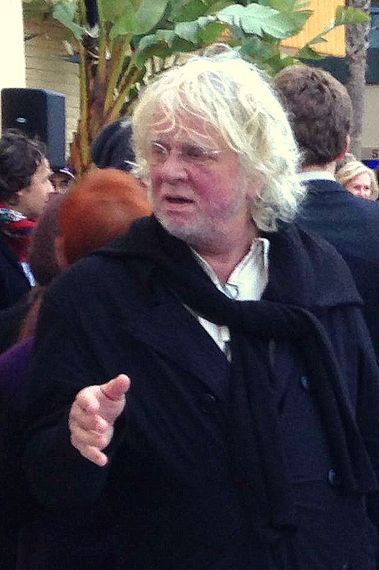
"Rather than dialogue and cooperatively compete with contemporaries," explains painter David Molesky, "Nerdrum has taught us the benefit of ignoring the packaging of time and to strive with masters of the past as if they were our peers." Striving to create an artistic dialogue with Apelles involves both research and considerable imagination since none of his works have survived, except in copies and descriptions.
History has noted Apelles as being an early advocate of a tetrachrome (four color) palette consisting of white, yellow ochre, red ochre and black: from this basic set of pigments a wide range of tints including flesh tones could be mixed. Apelles' technique also presages European oil painting methods: in his Natural History Pliny the Elder says that Apelles used a varnish on his paintings that 'caused a radiance in the brightness of all the colours and protected the painting from dust and dirt.' A lyrical painter whose works are recorded as having employed elaborate allegories and personifications, Apelles made a number of portraits of Alexander the Great including one of the young ruler wielding a thunderbolt.
Molesky, who studied with Odd Nerdrum between 2006 and 2008 says that the legend of Apelles came up as they looked over a book of Pompeian frescoes: Nerdrum told him that the paintings preserved by the ashes of Vesuvius were "copies upon copies" that echoed the original great works of Apelles.
"It really triggered my imagination," Molesky recounts, "to think about what these paintings must have looked like, these invisible paintings -- all destroyed 1200 years ago -- that were esteemed by Rembrandt, Titian, Botticelli and others as the greatest works ever, even though they had never seen them." Raphael, another admirer, portrayed himself as Apelles in his fresco The School of Athens which graces the Vatican's Apostolic Palace. In a sense, striving to emulate Apelles offers up the fantasy of joining what Molesky describes as "a secret bloodline of painters whose imaginations were ignited into fierce striving when the imagination was set to try and create something worthy of the Greek master."
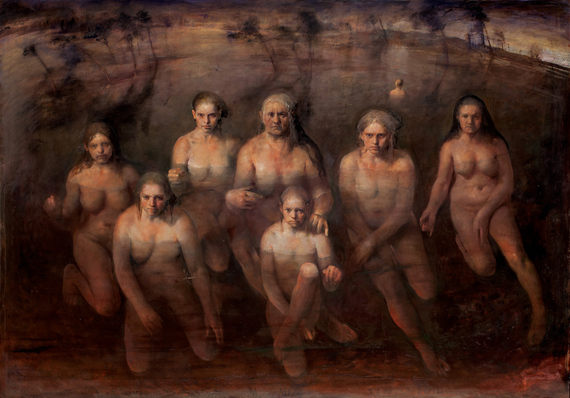
What would Apelles have thought of the rivetingly strange Maenads, the largest of six Nerdrum canvases on view at Copro? The subject is classical: maenads were women who resisted the worship of Dionysius and were driven mad by being forced to participate in rituals against their wills. Its seven nude figures, who rise from an ashen scrim of water, glower accusingly toward the viewer offering variations on the theme of refusal. One of them, second from the right, is androgynous or even masculine: in fact she/he resembles Nerdrum. Just what are these unwilling Northern bacchants accusing us of? I'm guessing fatuousness and inanity: their resistance and suffering are the emblems of their character. Like the asylum inmates that Gericault painted, Nerdrum's Maenads are to be both pitied and admired.
The characters in Nerdrum's paintings have some pretty weird circuses going on in their heads, and to like his paintings you have to buy into the lugubrious strangeness, which not everyone does. Jenny Dubnau, a realist painter who earned her MFA at Yale, argues that Nerdrum's imagery is "...like a parody of a Wagner opera or something: it feels like a very false, silly mythology that has no relevance to anything real in our culture. He himself describes his work as kitsch, but there's zero humor to it, so it's intensely unlikable." In contrast, the late critic Hilton Kramer (1928-2012) found Nerdrum's works valuable as cautionary tales: "They reject the present and exploit the past in favor of pictorial fable, allegory and myth that offers the viewer a grim symbolic account of the human condition in extremes."
For the past few decades, young artists interested in classical training -- exactly the "wrong" approach in an era dominated by postmodern theory -- have looked to Nerdrum as a beacon. His Road Warrior meets Rembrandt imagery and his considerable facility have made him a figure of considerable adulation. Luke Hillestad came to study at Nerdrum's farm after an art school put-down helped him clarify his sense of difference:
At 22 I made a picture of two lovers for an Art University. The teacher's only comment was that I "should get a job making covers for romance novels," which sparked chuckles in the classroom. I would have happily taken that job, as I would have been equally glad to make pictures for video games, if only I had those connections. While the University upheld Kant's call for disinterestedness, I was on an earnest search for beauty which pleasures and drama that delights. Odd's farm was a place that facilitated these desires.
Hillestad's melodramatic painting Abyss which depicts couple kissing in a water-filled cavern shows the tenderness and luminosity that was encouraged under Nerdrum's tutelage. Migration, Hillestad's image of a nomadic clan seems to be located in the precise mythological zone that Nerdum has invented, but its figures and surface are more carefully burnished. There is a hint of Pre-Raphaelite grace in Hillestad's female figures that gives his work its distinctive mood.
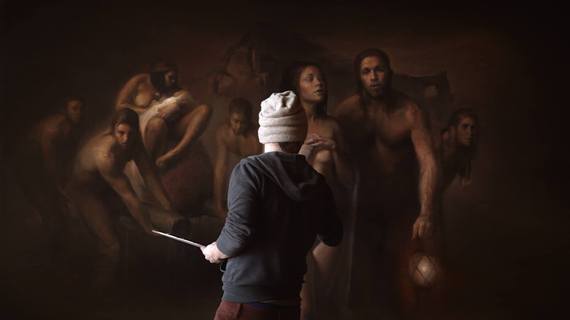
Caleb Knodell, who is represented by three oils including his glowering Self-Portrait as Possessed, found that his studies with Nerdrum offered both a sense of belonging and the support he needed to attempt challenging subject matter:
Working with Odd really isn't work. While it can be strenuous at times, it usually involves small things. He will say things like "we will do this, and then we will have a nice time."Whenever there was some big chore it was always followed by great food, relaxation, always coffee. He tends to always look at the other side of things. Not necessarily playing devil's advocate, but more so a sense that whatever the majority believes is probably wrong.
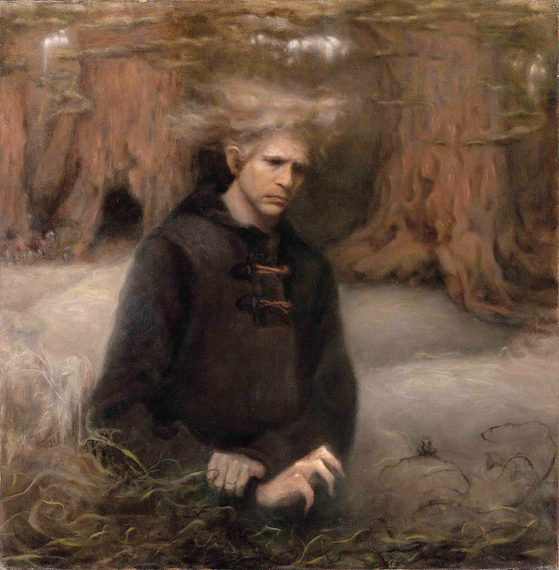
David Molesky, who first worked as an apprentice and model for Nerdrum at his studio in Iceland, found that his best moments with Nerdrum mainly consisted of watching Nerdrum paint and listening to his cultural anecdotes. Studying painting with Nerdrum -- in Paris, Reykjavik or Memorosa -- is rather like studying architecture with Frank Lloyd Wright at Talesin: just being in the presence of the master can be the most important aspect. Rose Freymuth-Frazier, who studied with Nerdrum in 2005 says: "Odd's very compelling, generous etc. A lot of people looking for that influence in their lives find that, even temporarily in him. He's bigger than life and he has the artistic mastery to back it up."
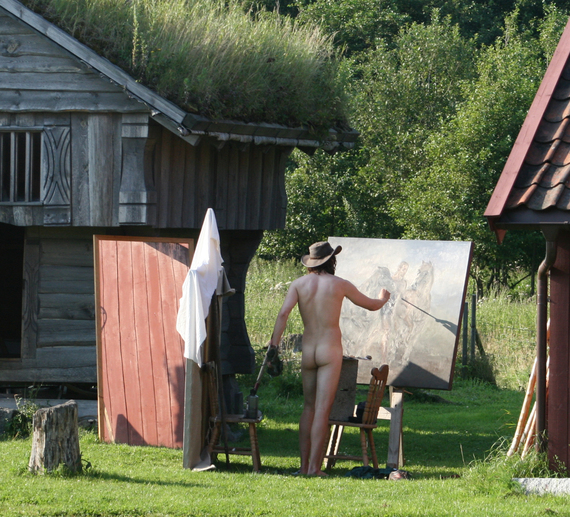
Of course, the adulation of masters is something that has to come to an end at a certain point. When asked why had had left the studio of the sculptor Rodin, Constantin Brancusi famously replied: "No other tree can grow in the shadow of a great oak." For that reason, David Molesky's paintings, which have moved from Nerdrum's Nordic mythological zone into a contemporary world filled with depictions of fiery confrontations and conflagrations, offer a welcome indication of artistic separation and maturation.
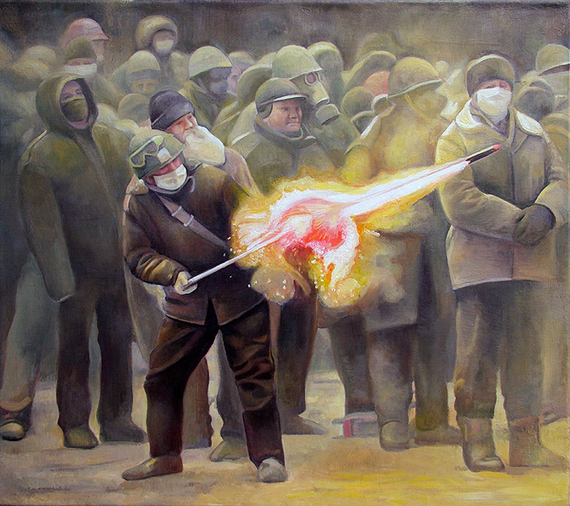
From Odd Nerdrum, his first master, Molesky learned the importance of drama and atmosphere. Apelles, his second master, helped him realize that the imagination is a much broader field than any one person could ever show you. Artists who never walk away from the shadows of their masters risk being what the Greeks called epigones: less distinguished followers or imitators.
Pupils of Apelles
Odd Nerdrum, Luke Hillestad, Caleb Knodell, David Molesky
Extended through January 2nd, 2015
Copro Gallery
Bergamot Arts Complex,
2525 Michigan Ave T5
Santa Monica, CA 90404